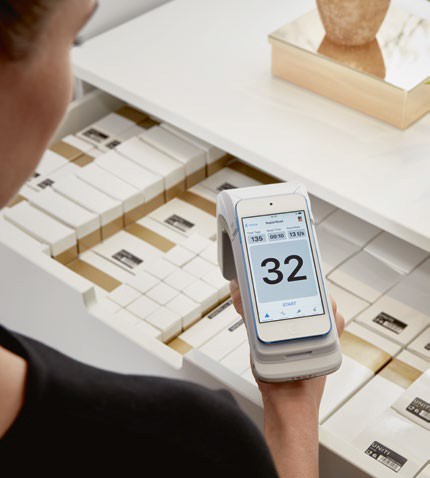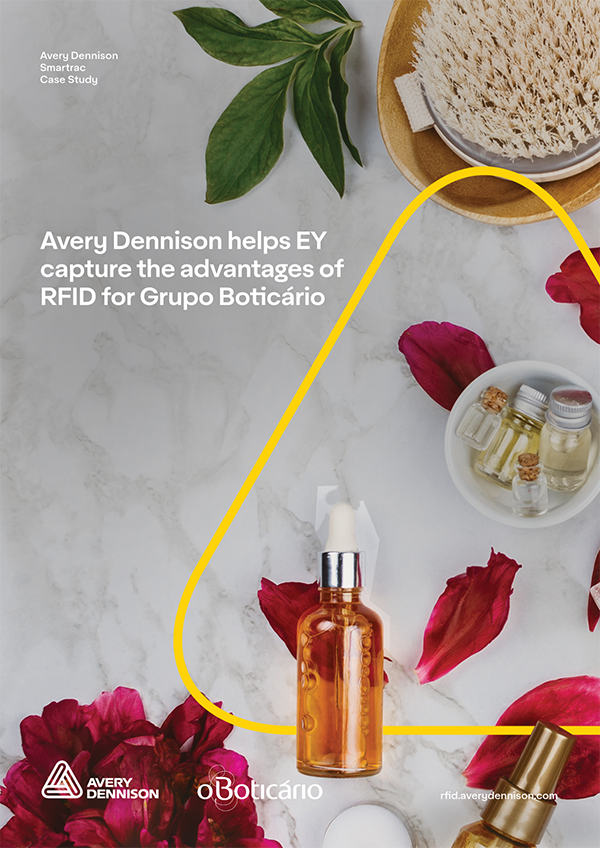Laying the foundation
Before launching the pilot, the EY / Grupo Boticário project team designed the required IT infrastructure, opting to build a separate, RFID-based system for the purposes of the test, so its performance could be compared with the company’s legacy system. Applications in the DCs and stores ran with middleware hosted on Grupo Boticário’s servers, with all DC process and stores operating on the same middleware. Fixed readers were used to scan RFID tags at the DCs; at stores, staff used handheld readers for tracking inventory, and pad readers were used at checkout. The tests adhered to GS1 EPC UHF standards.
The team also exhaustively tested the placement of tags on more than 2,000 SKUs, and multiple product types. They tested tags under varying conditions, working with Grupo Boticário’s packaging designers to arrive at tag positions that offered the right balance of function and aesthetics. Additional testing by Avery Dennison’s technical experts added another layer of confidence. Together we’ve now tagged more than 1.2 million items.
All that careful testing sometimes left little lead time for ordering tags. “We had a challenging timeline,” acknowledges Fabiano. “But Avery Dennison was able to fulfill and deliver orders as fast as we needed.”
Testing begins
For in-store visibility, RFID tags are attached to individual items. They can be read on the shelf, in the stockroom, at the point of sale, and even at store exits. The same item-level tags also can lend visibility to individual items as they pass from manufacture through the supply chain.
For the pilot, RFID tagging took place near the end of the outbound process at one of Grupo Boticário’s distribution centers. DC personnel first registered every shipping carton and each of the products inside by scanning their SKU numbers into a database. Then they printed RFID tags associated with each SKU number on Avery Dennison ADTP1 printers and applied the tags to the cartons and the items within them. Finally, each carton was checked before shipping to make sure there was an RFID tag for every recorded SKU. (As part of the pilot, the team also tested tagging at the end of a packaging line at a Grupo Boticário factory, and there, as in the DCs, were able to read several hundred items in a single carton in a matter of seconds).
Cartons were shipped to four stores—two retail stores, and two wholesale stores selling products to the company’s direct-sales representatives. At the stores, the RFID system was applied to improve five processes: shipment receipt, shelf replenishment, inventory counting, checkout, and demand planning.
Store employees saw improvements right away
Received shipments could be checked in faster and more accurately, with employees able to check-in all items in a carton with a click of a scanner outside the box, rather than opening the carton and checking in each item one by one. Inventory could be categorized in the store’s database as “back of store” or “front of store,” making it easy to see at a glance when shelves needed replenishing—and making it possible to track merchandise from back to front when it was moved. Alerts about products with imminent expiration dates enabled store staff to discount those items and sell them before they expired, capturing more revenue and reducing waste. At checkout counters, multiple products could be rung up all at once, rather than item by item. And inventory could be counted in a fraction of the time it took with the legacy barcode system, and with greater accuracy. As a result, demand planners received better information that enabled them to order the right products for replenishment and better forecast sales.





